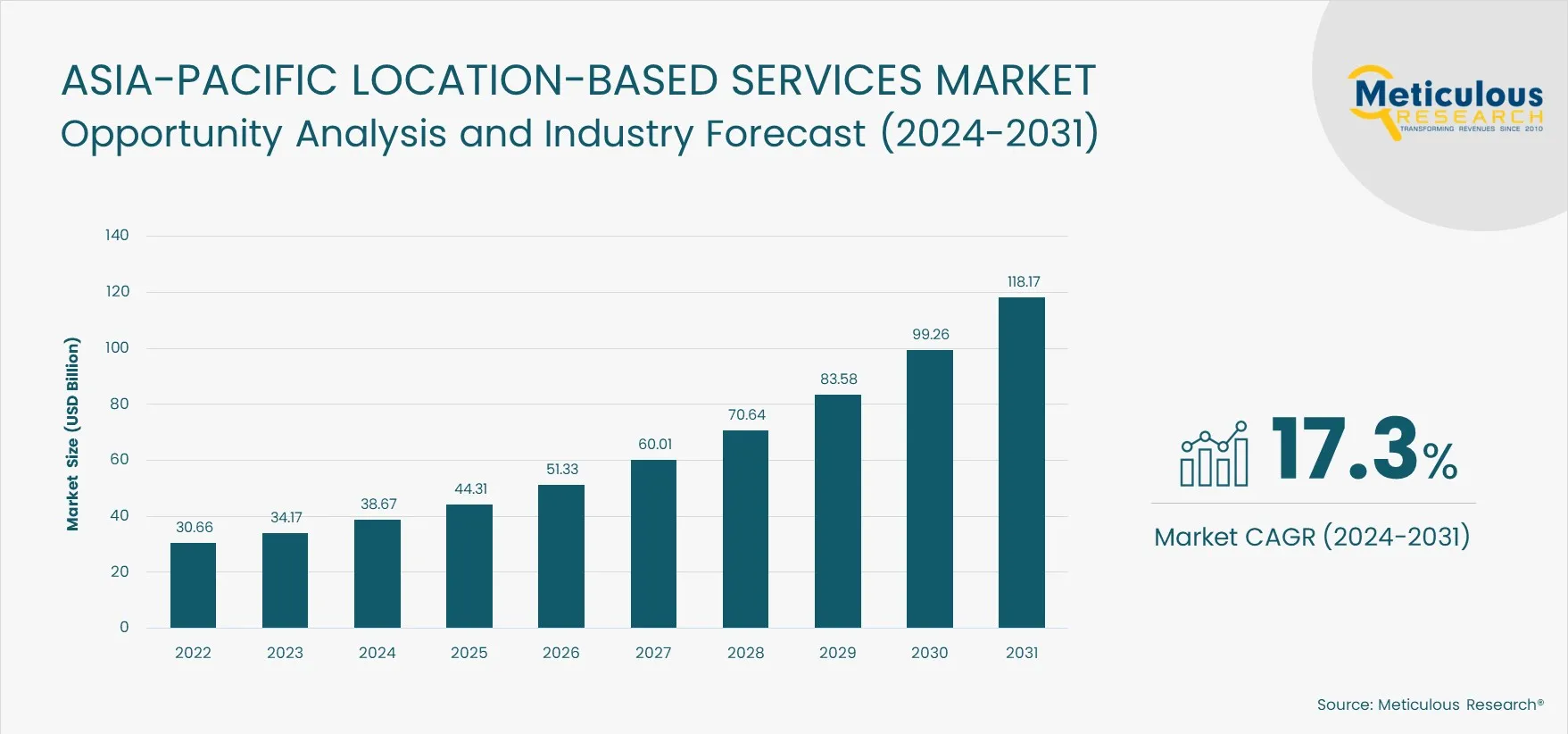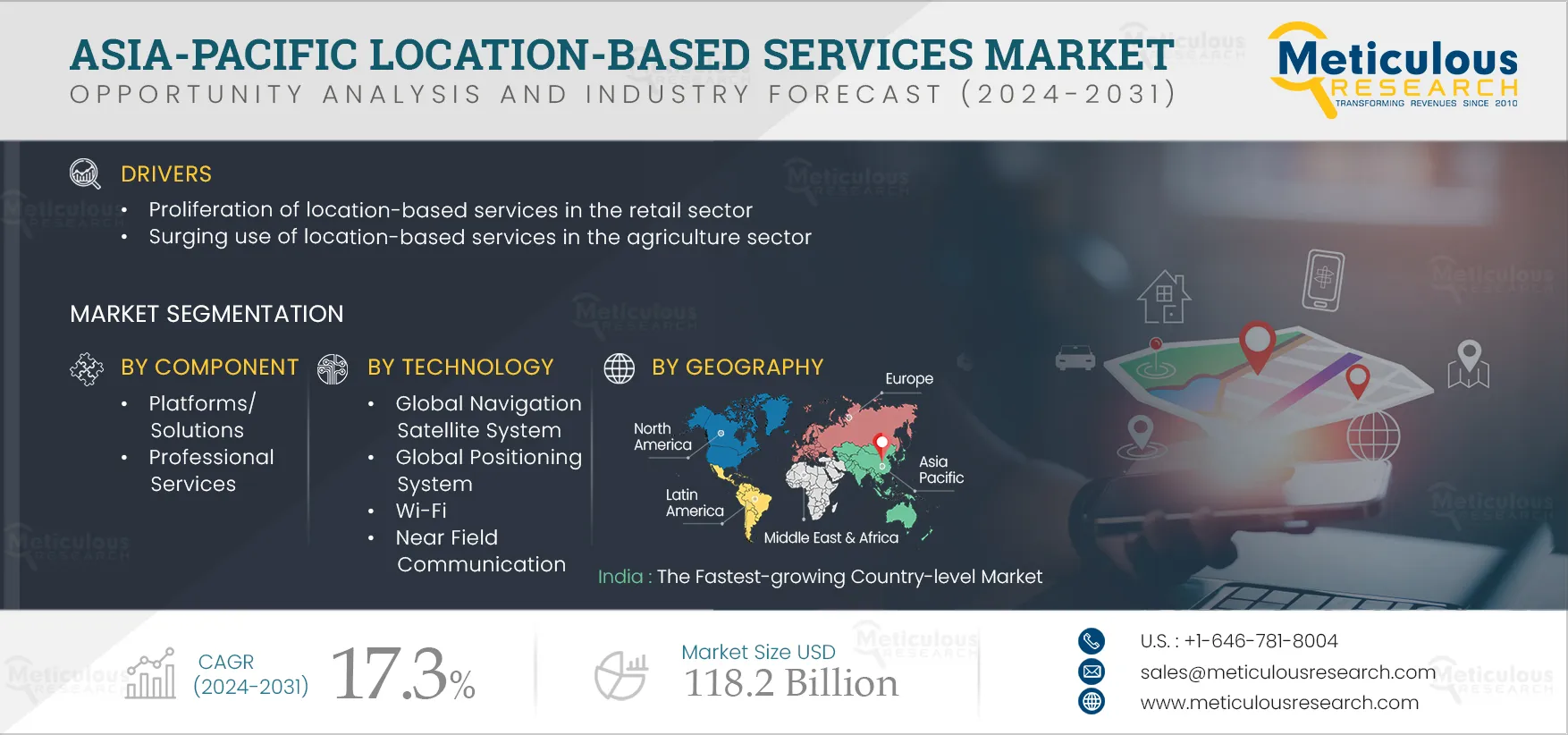The Asia-Pacific Location-based Services Market to reach $118.2 billion by 2031 at a CAGR of 17.3% during the forecast period 2024–2031. The growth of the Asia-Pacific location-based services is driven by the proliferation of location-based services in the retail sector and the surging use of location-based services in the agriculture sector. However, dynamic government rules and regulations for location-based services restrain the growth of this market. Furthermore, constant upgrades in mapping and navigation solutions are expected to generate growth opportunities for the players operating in this market. However, the high costs of procuring and implementing location-based services are a major challenge impacting market growth. Additionally, the use of 5G technology for improved real-time analysis and the development of GIS software using augmented reality (AR)/virtual reality (VR) technologies are prominent trends in this market.
Here are the top 10 companies operating in the Asia-Pacific Location-based Services Market
HERE Global B.V.
HERE Global B.V. is a location data and technology platform provider that enables businesses, consumers, cities, and governments to turn location data into value quickly and efficiently at a scale. The company provides solutions for use cases such as autonomous vehicles, digital twins, and smart city infrastructure that rely on precise location data.
The company’s offerings cater to various industries, including automotive, transport and logistics, technology, media, telecommunications, retail, public sector, finance & insurance, manufacturing, accommodation & food services, utilities, healthcare, and consumer electronics. Furthermore, the company provides support from map customization to location applications, visualization & business analysis, tracking assets and capital goods, and providing support to autonomous vehicles. It provides solutions for several use cases, such as connected driving, fleet management, supply chain, urban mobility, consumer engagement, and 5G network planning.
Google LLC
Google LLC is a multinational technology company focusing on artificial intelligence, online advertising, search engine technology, cloud computing, computer software, quantum computing, e-commerce, and consumer electronics. The company provides methods and systems for location-based services such as social networking, demographic information, mobile tracking, and location navigation systems. Google provides location-based social software for mobile devices. It offers platforms in several areas, including location-based advertising, fleet management, mapping & navigation, local search & information, google beacons & proximity marketing, and an asset tracking platform.
The company offers a mapping and navigation solution, the Google Maps platform, that provides directions, traffic information, street view imagery, and various location-related features. The Google Maps platform is used for finding directions and exploring places.
TomTom N.V.
TomTom N.V. is a leading mapmaker that provides location technology for drivers, carmakers, enterprises, and developers. The company provides highly accurate maps, navigation software, real-time traffic information, and APIs for smart mobility applications. As a leading independent location technology specialist, TomTom has decades of experience in the world’s most innovative mobility technologies, such as navigation software for multiple car brands, APIs and SDKs for leading technology companies, maps for navigation, and traffic and hazard data for several consumers. The company provides its customers with a location platform with the most up-to-date and relevant geographic content and mobility technologies, including maps, navigation software, connected services, and APIs. The company offers solutions for several applications, such as automotive, fleet management and logistics, mobility and on-demand, road traffic management, and location intelligence.
The company operates in two segments: Location Technology and Consumer. Through its Location Technology segment, the company provides maps, navigation software, and services to be integrated into customers’ applications through two sales channels: Automotive and Enterprise. The Consumer Electronics segment offers drivers navigation, including directions, guidance, and route planning information. Furthermore, the company offers portable navigation devices and mobile applications to enable smarter driving decisions.
Esri
Esri is a global market leader in GIS solutions. The company offers ArcGIS, a powerful mapping & spatial analytics software. ArcGIS solution combines mapping and data analytics to deliver location intelligence and meet digital transformation needs for organizations of all sizes. Esri offers GIS solutions mainly for the commercial, government, manufacturing, and utility sectors. The company offers various location data products such as Esri Data, Business and Behavioural, and Environmental, Esri Demographics, Esri Reports, and Esri Tapestry Segmentation for several industries such as architecture, engineering & construction, education, energy utilities, health & human services, government, public safety, telecommunications, and transportation.
Hexagon AB
Hexagon AB is a global leader in digital reality solutions, combining sensor, software, and autonomous technologies. The company’s solutions are categorized into real-time location intelligence solutions, autonomy & positioning solutions, geospatial solutions, defense & intelligence solutions, and reality capture solutions. The company offers solutions via several divisions, such as Agriculture, Autonomy & Positioning, Geospatial, Geosystems, Manufacturing Intelligence, Mining, PPM, Safety & Infrastructure, and Xalt Solutions.
The company operates in two segments: Industrial Enterprise Solutions (IES) and Geospatial Enterprise Solutions (GES). Geospatial Enterprise Solutions (GES) includes a world-leading portfolio of reality-capture sensors—from laser scanners, airborne cameras, and UAVs (unmanned aerial vehicles) to monitoring equipment, mobile mapping technologies, and precise positioning. Industrial Enterprise Solutions (IES) includes a world-leading portfolio of metrology systems incorporating the latest sensor technology for fast and accurate measurements. These solutions include technologies such as coordinate measurement machines (CMM) and laser trackers and scanners for optimizing design, processes & throughput in manufacturing facilities and CAD (computer-aided design), CAM (computer-aided manufacturing), and CAE (computer-aided engineering) software.
Trimble Inc.
Trimble Inc. is a technology company that provides positioning, modeling, connectivity, and data analytics solutions that enable customers to improve productivity, quality, safety, and sustainability. The integration of sensors, software, connectivity, and information in the product portfolio offers a unique ability to provide an information model specific to the customer’s workflow. Furthermore, Trimble offers software products & services ranging from embedded real-time firmware to application software that integrates field data with large-scale enterprise back-office applications. The company provides comprehensive solutions across various sectors, including architecture, building construction, civil engineering, geospatial, survey & mapping, agriculture, natural resources, utility, transportation, and government.
The company operates in four segments: Buildings and Infrastructure, Resources and Utilities, Geospatial, and Transportation. The Buildings and Infrastructure segment primarily serves customers working in architecture, engineering, construction, and operations and maintenance. The Geospatial segment primarily serves customers working in surveying, engineering, and government. The Resources & Utilities segment primarily serves customers working in agriculture, forestry, and utilities. The Transportation segment provides capabilities for the long-haul trucking and freight shipper markets to create a connected supply chain and integrate all forms of transportation, drivers, back-office management, shippers, and freight.
Cisco Systems, Inc.
Cisco Systems, Inc. is a technology company that provides location-based solutions in several categories, including location analytics, customer engagement toolkits, asset management, enterprise application integrations, and location-data APIS. Furthermore, it provides location-based advertising, fleet management, mapping & navigation, proximity marketing, and wireless RFID asset tracking solutions. The company provides real-time location-based services using positioning technologies, WLAN, LWAPP, Wi-Fi, and RFID tags.
The company offers an industry-leading portfolio of technology innovations with networking, security, collaboration, and cloud management. The company offers Cisco Spaces location analytics that filter data based on parameters such as time, date, and geography. Cisco Smart Workspaces provides employee safety, productivity, experience, and space utilization using rich maps and existing network infrastructure.
QUALCOMM Incorporated is a leading developer of Assisted-GPS (A-GPS), Assisted Global Navigation Satellite System (A-GNSS), and WLAN positioning technologies. The location-based services offered by the company support multiple constellations for A-GNSS, including GPS, GLONASS, Galileo, NavIC, and BeiDou; Wi-Fi-based and Bluetooth-based positioning for WLAN, including Wi-Fi RSSI (received signal strength indication) and Wi-Fi RTT (round-trip time) signals for indoor location; observed time difference of arrival positioning for LTE access and third-party inertial sensors. The company also develops and commercializes key technologies used in mobile and other wireless devices. Some of these inventions are contributed to and commercialized as industry standards, such as certain video and audio codecs, Wi-Fi, GPS (Global Positioning System), and Bluetooth.
The company operates in three segments: QCT (Qualcomm CDMA Technologies), QTL (Qualcomm Technology Licensing), and QSI (Qualcomm Strategic Initiatives). The company provides multi-frequency GNSS-enabled platforms that support concurrent multi-constellation operations on the L1, L2, and L5 frequency bands. Qualcomm Dead Reckoning software uses vehicle information and inertial sensors in addition to GNSS to extend coverage and improve performance in GNSS-denied or compromised environments. Qualcomm offers vision-enhanced precise positioning (VEPP) that adds camera and GNSS corrections to provide lane-level accurate positioning in the global frame in virtually all environments using Snapdragon platforms.
Microsoft Corporation provides Azure location-based services, including a set of APIs that provide mapping, search, routing, traffic, and time zones available through Azure. The company provides solutions for various applications, including location-based advertising, fleet management, mapping & navigation, local search & information, proximity marketing, and asset tracking. Furthermore, it provides solutions for location intelligence services, location data services, routing services, and logistics services.
The company operates in three segments: Intelligent Cloud, Productivity and Business Processes, and More Personal Computing. The company’s location intelligence services leverage high-powered geocoding and reverse geocoding with the location and location recognition APIs.
AT&T Inc.
AT&T Inc. is a global provider of location-based services platforms. The company provides several platforms such as location-based messaging, AT&T secure family, HARMAN spark, AT&T store locator, location-based marketing service, and location tracking wearable devices. The company provides sophisticated GPS tracking solutions, hardware, software, and support services for GPS fleet tracking. Furthermore, it offers advanced GPS tracking software and IoT devices that track vehicles and assets in near real-time.
The company operates in two segments: Communications and Latin America. The company offers location-based solutions and services for a wide range of industries such as healthcare, retail, financial services, transportation, hospitality, manufacturing, and energy & utilities.

























